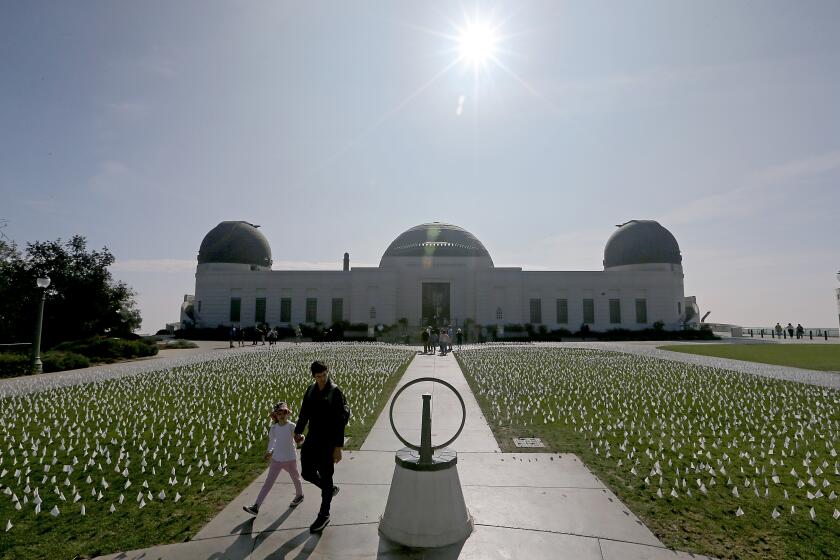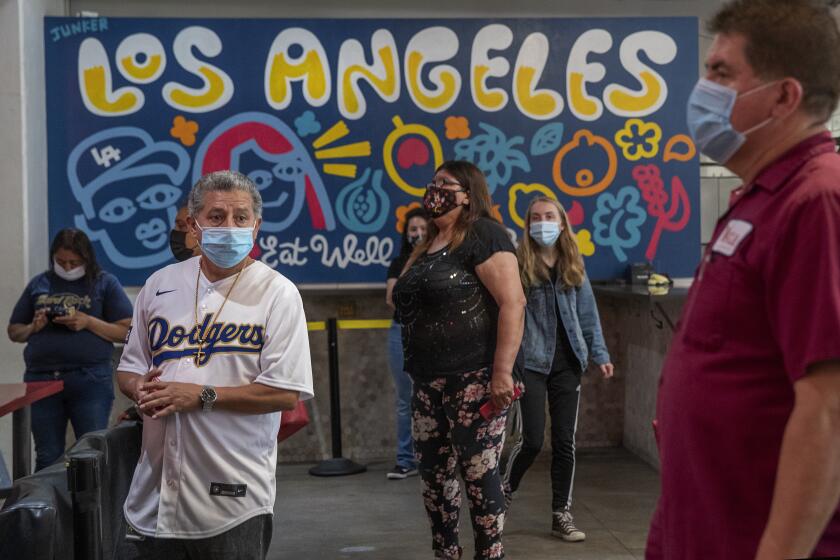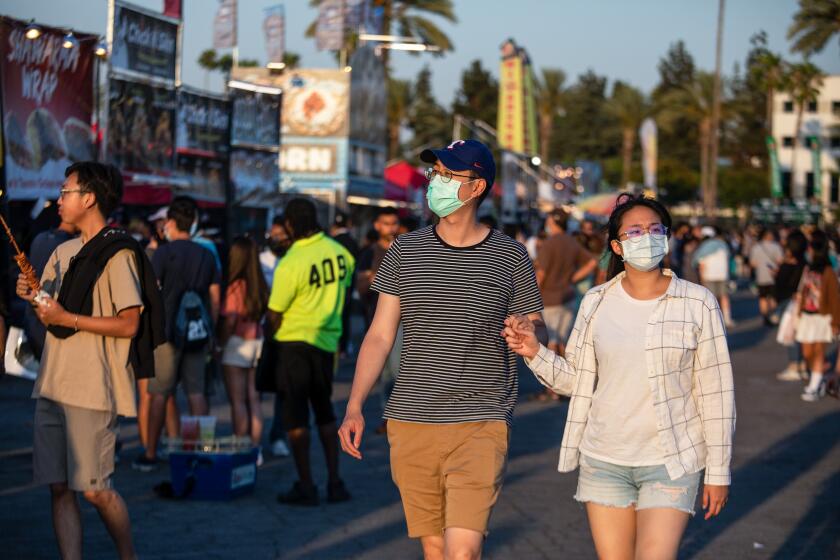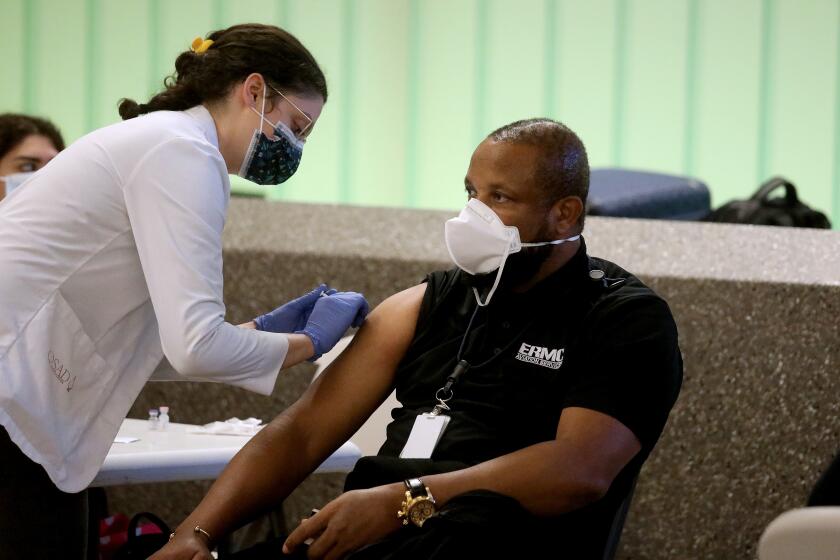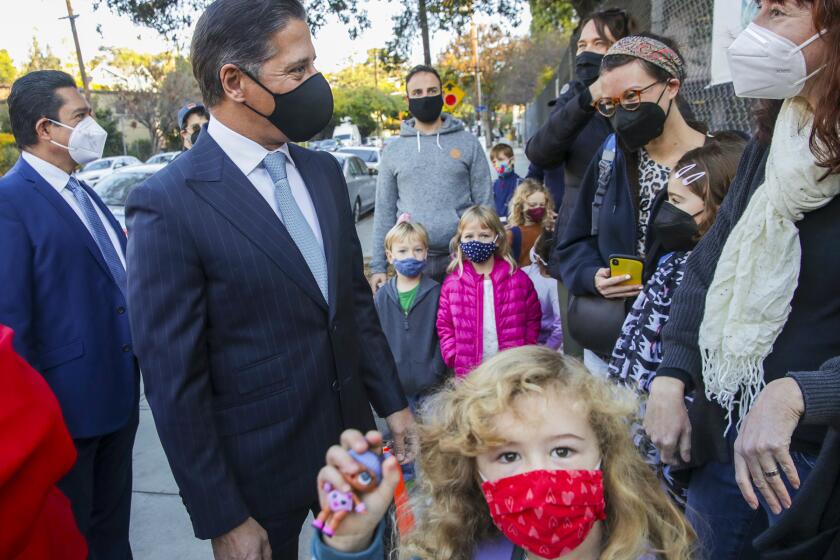Why California is hoping people keep wearing masks even as coronavirus cases fall
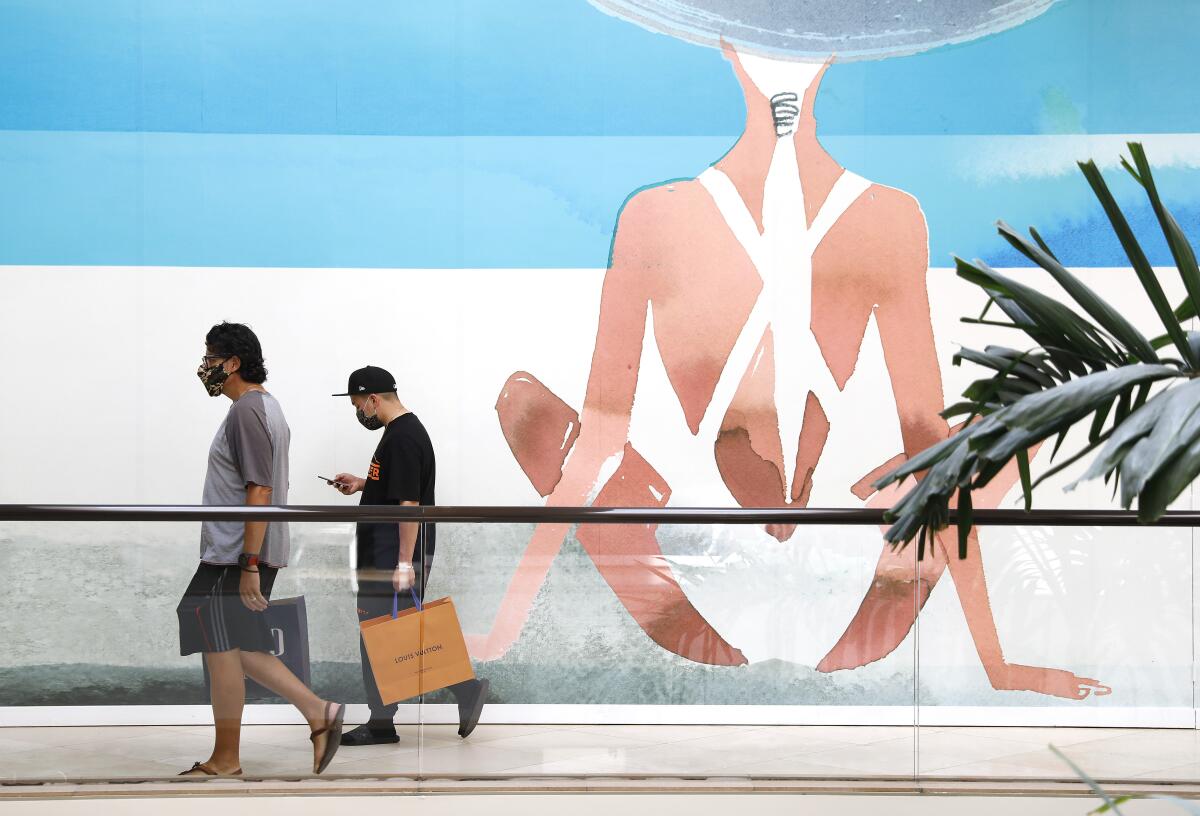
Even as California begins to loosen its mask requirements, some top health officials are strongly recommending the public still wear face coverings, saying the state’s earlier pandemic experiences illustrate the need for continued vigilance.
With the Omicron wave still fresh in the minds of residents and policymakers alike, officials are casting Wednesday’s lifting of a statewide indoor mask mandate in a cautiously optimistic light — a departure from the more celebratory tone seen eight months ago, when California lifted virtually all coronavirus-related restrictions on businesses and public spaces.
“Unlike June 15th, I think it’s a really strong part of the message that masks are a valuable tool,” said Dr. Mark Ghaly, California’s health and human services secretary, referring to the state’s “reopening” day.
The state will reassess conditions at the end of the month before making a decision on school masking rules.
As of mid-June, the state had reported 3.9 million coronavirus cases and more than 62,000 COVID-19 deaths. Now, California has reported more than 8.8 million cumulative coronavirus cases, and the total death toll exceeds 82,000.
Although the state has seen significant declines in the numbers of new coronavirus infections and people hospitalized with COVID-19 in recent weeks, the Omicron surge is still exacting a hefty price.
Recently, California has been reporting 210 to 215 COVID-19 deaths a day, worse than the peak of 135 deaths a day recorded during last summer’s Delta surge.
Los Angeles County on Wednesday crossed another grim milestone: reporting its 30,000th COVID-19 death.
The milestone came on Wednesday, when 102 deaths were reported, the second-highest daily death toll recorded in 11 months.
Even with the indoor mask mandate now lifted statewide, Ghaly said California is “still strongly recommending that people wear them in public indoor places.” That’s a choice facing those who have been vaccinated against COVID-19, as unvaccinated residents are still required to wear face coverings indoors.
There also remain plenty of settings where everyone must mask up, including in nursing homes or while aboard public transit. A universal indoor mask mandate will also persist for California’s K-12 schools at least through the end of the month, pending further evaluation of pandemic trends.
However, Ghaly expressed optimism this week that the state will soon be able to alter face covering rules for schoolchildren.
Even as California’s mask order is set to expire next week, health officials are still encouraging people to wear masks while transmission rates are up.
Wednesday’s change to the state’s guidance immediately affected counties such as San Diego, Orange, Riverside and San Bernardino that never implemented a universal mask-wearing order in indoor public spaces after last year’s Delta surge. A number of other counties also lifted their local masking orders the same day, including Ventura, Santa Barbara, San Luis Obispo and most of the San Francisco Bay Area.
But several California counties, such as Los Angeles, Santa Clara and Mendocino, are taking a more cautious approach and opting to retain their local mask mandates for, likely, a few more weeks. Palm Springs is sticking with a local indoor mask order too.
Coronavirus case rates remain quite high, even if they are dropping rapidly. The U.S. Centers for Disease Control and Prevention suggests everyone mask up in indoor public settings if there are 50 or more cases a week for every 100,000 residents. Southern California’s case rate is about 267; in Greater Sacramento, it’s 290; the Bay Area, 298; rural Northern California, 363; and the San Joaquin Valley, 382.
California is reporting about 15,000 cases a day over the last week. While that’s significantly below the Omicron peak of more than 123,000 cases a day, and last winter’s peak of 46,000 cases a day, the latest number is still at roughly the same level as the peak of the troubling summer Delta surge.
And while vaccines reduce the risk of infection — and especially severe illness and death — it’s now clear that, with the rise of Delta and Omicron, vaccinated people can still get infected and spread the virus to others.
People can go without face coverings outdoors, including at K-12 schools, childcare facilities and in exterior areas of ‘mega’ events.
Some health officials say it’s better to wait to ease up on mask wearing until case rates drop further, reducing your chance of infection by waiting until there are fewer contagious people around.
“I think it’s important for our residents to continue to take precautions, especially, again, if they’re around loved ones who are unvaccinated, or around loved ones who are immunocompromised or just vulnerable,” said Dr. Regina Chinsio-Kwong, a deputy health officer for Orange County.
“For the vulnerable population,” she added, “sometimes a vaccine may not be as effective, and so using other strategies to reduce risk of COVID infection is still very important.”
Some health officials in the San Francisco Bay Area echoed that sentiment.
“Masking will continue to be an important layer of protection as we move forward and learn to live with COVID,” said Dr. Nicholas Moss, the health officer for Alameda County, the second-most populous county in the Bay Area. “You should feel comfortable continuing to wear your mask when you need an additional layer of safety, and confident that you are making the safest choice for yourself and your loved ones.”
Long-lasting complications from surviving COVID-19 also remain a threat. A study published this month in the journal Nature Medicine found that those who have survived COVID-19 are at increased risk of cardiovascular disease, including heart disease, heart inflammation and heart failure, compared with those who didn’t have COVID-19.
A CDC report found vaccine booster protection waned but remains strong amid the Omicron wave.
The additional risk to the heart was present even among people who did not need to be hospitalized, according to the study, which reviewed more than 150,000 COVID-19 patients cared for by the U.S. Department of Veterans Affairs.
“The risks were evident regardless of age, race, sex and other cardiovascular risk factors, including obesity, hypertension, diabetes, chronic kidney disease and [high cholesterol]; they were also evident in people without any cardiovascular disease before exposure to COVID-19, providing evidence that these risks might manifest even in people at low risk of cardiovascular disease,” the report said.
“Governments and health systems around the world should be prepared to deal with the likely significant contribution of the COVID-19 pandemic to a rise in the burden of cardiovascular diseases.”
Health officials also are expressing ongoing concerns about long COVID, a collection of illnesses that can persist for months or longer after a coronavirus infection, even if the original infection resulted in mild illness or there were no initial symptoms. Some experts expect to see a new wave of long COVID patients associated with the latest Omicron surge.
Symptoms of long COVID include difficulty breathing; fatigue; symptoms that get worse after physical or mental activities, known as post-exertional malaise; difficulty thinking or concentrating, sometimes called brain fog; cough; chest pain; headache; fast-beating or pounding heart; joint or muscle pain; “pins-and-needles” feeling; diarrhea; sleep problems; fever; lightheadedness; rash; mood changes; change in smell or taste; and changes in menstrual period cycles.
“Certainly, long COVID is something that we take very seriously,” Dr. Anthony Fauci, President Biden’s chief medical advisor, told reporters Wednesday. “You don’t necessarily have to be hospitalized to get long COVID.”
L.A. County Public Health Director Barbara Ferrer has voiced concerns about a large number of people who suffer from long COVID after being infected with earlier strains of the coronavirus. That’s why, she said, people should not interpret Omicron’s typically milder infections as a reason to think the variant is as harmless as the common cold or the flu.
“For some people, they have very mild [COVID] illness and then, three months later, they have some really pretty debilitating health issue related to the virus’ infection,” Ferrer said. The coronavirus “remains a virus that can cause very serious disease.”
Ferrer also expressed concern about the potential for Omicron to cause multisystem inflammatory disease in children, or MIS-C, a rare but potentially deadly illness that can result from a coronavirus infection. Across California, 817 children have been diagnosed with the inflammatory disease, and eight deaths have been reported.
“So I think caution is still the appropriate strategy for all of us, given how extraordinarily high our rates of transmission still are,” Ferrer said.
Once the global epicenter of the COVID-19 crisis, Europe is looking to return to something close to normal.
But even in counties that are taking a more cautious approach than the state, officials say they believe they’ll be positioned to rescind mask rules in a matter of weeks.
L.A. County officials have said they will lift the local indoor mask mandate for vaccinated people seven days after the local coronavirus case rate falls under 50 a week for every 100,000 residents, which equates to below 730 cases a day.
For the last couple of weeks, the county’s daily case rate has been cut in half every week. From Jan. 26 to Feb. 1, an average of 17,000 cases a day were reported. The following week, the average was 9,000; for the most recent week, it was 4,000.
At this pace, L.A. County would be on track to reach its self-set threshold around mid-March and largely lift its indoor mask rules later that month.
Santa Clara County officials also estimate they’ll reach a case rate low enough to lift their indoor mask order next month.
While not following the state’s lead on indoor masking, L.A. County did on Wednesday lift another mask requirement that applied to outdoor “mega” events — such as those at the Hollywood Bowl, Dodger Stadium, SoFi Stadium and Los Angeles Memorial Coliseum — and outdoor spaces at K-12 schools and child-care settings.
Supt. Alberto Carvalho said it was premature to discuss the parameters for lifting the indoor mask mandate.
The CDC is planning on updating its guidance on mask wearing — aiming to account for the latest pandemic control tools now available, like vaccines, boosters and treatments, while still making sure to keep hospital emergency rooms from being overwhelmed in possible future surges.
“We’ll soon put guidance in place that is relevant and encourages prevention measures when they are most needed to protect public health and our hospitals,” CDC Director Dr. Rochelle Walensky told reporters Wednesday. “We want to give people a break from things like mask wearing when these metrics are better, and then have the ability to reach for them again should things worsen.”
Walensky said it’s still important to wear a mask if you’re feeling unwell, if you’re within 10 days after a COVID-19 diagnosis or if you are quarantining following exposure to someone who’s infected.
While the pandemic is continuing a downward trajectory, Fauci said vaccination and booster shots will be critical in maintaining that momentum. Officials are carefully monitoring the potential need for a second booster shot — a fourth dose of vaccine for those who originally got the two-dose Pfizer-BioNTech or Moderna vaccination series, or a third dose for those who were originally inoculated with the Johnson & Johnson shot, Fauci said.
“We’re moving toward a time when COVID isn’t a crisis, but is something we can protect against and treat,” said Jeff Zients, the White House COVID-19 response coordinator.
Times staff writers Anumita Kaur and Sean Greene contributed to this report.
More to Read
Start your day right
Sign up for Essential California for news, features and recommendations from the L.A. Times and beyond in your inbox six days a week.
You may occasionally receive promotional content from the Los Angeles Times.

